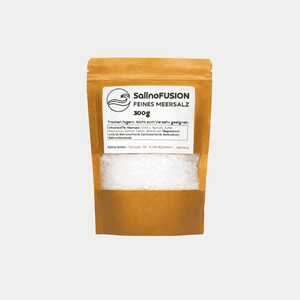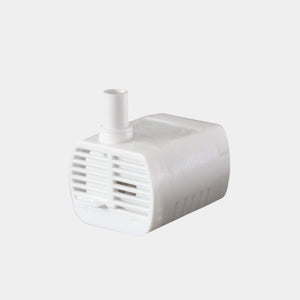Reading time: 12 minutes
Have you ever wondered why you sometimes feel tired, unwell, or even slightly cold after a long day at home? The answer could literally lie in the air you breathe. What many people don't realize is that the air quality in our apartments and houses is often significantly worse than the air outside – even in urban areas. Scientific studies show that the concentration of pollutants indoors can be up to five times higher than outdoors.
This finding becomes especially important when you consider that we spend an average of 80 to 90 percent of our time indoors. For people with respiratory diseases such as asthma, bronchitis, or COPD , indoor air quality can even mean the difference between a symptom-free day and a flare-up of symptoms.
But there's good news: With a few simple yet effective measures, you can significantly improve the air quality in your home – without expensive renovations or complicated technology. In this article, we present seven practical steps that everyone can take to breathe better at home.
Step 1: Regular ventilation – the basis for healthy indoor air
 As obvious as it may sound, proper ventilation is the simplest and most effective way to improve indoor air quality. But there's a difference between effective ventilation and simply opening a window.
As obvious as it may sound, proper ventilation is the simplest and most effective way to improve indoor air quality. But there's a difference between effective ventilation and simply opening a window.
Ventilation has proven particularly effective: Open all windows wide for about 5-10 minutes several times a day to allow for complete air exchange. This method is more energy-efficient, even in winter, than constant ventilation through tilted windows, which can cool the walls and prevent complete air exchange.
The optimal ventilation frequency depends on various factors:
- In living rooms: at least twice a day
- In bedrooms: before going to bed and after getting up
- In the kitchen: immediately after cooking
- In the bathroom: after showering or bathing
Particular attention should be paid to ventilation during the heating season. The dry air from heating can dry out mucous membranes and thus increase susceptibility to infection. Here, too, it's better to ventilate briefly and thoroughly several times a day than to leave a window open permanently.
In humid weather, ventilation may seem counterproductive, but it is nevertheless important. Warm indoor air can absorb more moisture than cold outdoor air, despite high outdoor humidity. Therefore, after the air exchange, the absolute humidity in the room decreases.
Tip: Set a ventilation alarm on your smartphone or use everyday routines as reminders – for example, after every meal or during commercial breaks on TV.
Step 2: Plants as natural air purifiers
 Houseplants aren't just decorative elements; they're truly multitalented when it comes to improving indoor air quality. NASA examined various plants for their air-purifying properties in its famous Clean Air Study . The results are impressive: Certain plant species can actively filter pollutants such as formaldehyde, benzene, and trichloroethylene from the air.
Houseplants aren't just decorative elements; they're truly multitalented when it comes to improving indoor air quality. NASA examined various plants for their air-purifying properties in its famous Clean Air Study . The results are impressive: Certain plant species can actively filter pollutants such as formaldehyde, benzene, and trichloroethylene from the air.
Particularly effective green air purifiers include:
- Pothos (Epipremnum aureum) : A classic houseplant that filters formaldehyde particularly well.
- Peace Lily (Spathiphyllum) : This elegant plant with white flowers removes benzene, formaldehyde and trichloroethylene from the air.
- Snake plant (Sansevieria) : A robust air purifier that produces oxygen and filters pollutants even at night.
- Spider plant (Chlorophytum comosum) : Easy to care for and effective against formaldehyde and carbon monoxide.
- Dragon tree (Dracaena) : Different species of this plant genus can absorb different pollutants.
For a noticeable effect, experts recommend about one medium-sized plant per 10 square meters of living space. Make sure to distribute it wisely: Nocturnal plants like snake plants, which produce oxygen and absorb carbon dioxide even at night, are particularly suitable for bedrooms.
Allergy sufferers should be aware that not all plants are equally well tolerated. Plants with a strong odor or pollen can cause discomfort. Ferns, palms, and the aforementioned snake plants are particularly suitable in this regard.
When caring for plants, however, you should ensure that the soil doesn't get too moist, as this can lead to mold growth, which in turn impairs air quality. A good compromise is to use hydroponic soil or special potting soil with mold protection.
Step 3: Optimally regulate humidity
 The right humidity in living spaces is an often underestimated factor for healthy living and easy breathing. The ideal relative humidity is between 40 and 60 percent. Not only do residents feel most comfortable in this range, but mucous membranes also remain well-moisturized and the proliferation of mold and dust mites is inhibited.
The right humidity in living spaces is an often underestimated factor for healthy living and easy breathing. The ideal relative humidity is between 40 and 60 percent. Not only do residents feel most comfortable in this range, but mucous membranes also remain well-moisturized and the proliferation of mold and dust mites is inhibited.
Air that's too dry (below 30 percent) can lead to irritated mucous membranes, dry eyes, and increased susceptibility to infections. This is especially problematic during the heating season. Air that's too humid (over 65 percent), on the other hand, promotes the growth of mold and dust mites.
Simple natural methods to increase humidity include:
- Water bowls on the heater
- Indoor fountains or water features
- Damp towels on the radiator (use caution as mold may occur)
- Regularly spraying houseplants (also creates a short-term increase in humidity)
If the humidity is too high, the following can help:
- Consistent ventilation, especially after showering or cooking
- Avoid drying laundry in living spaces
- If problems persist: Use a dehumidifier
Analog or digital hygrometers are useful for monitoring humidity. These inexpensive devices should be in every household and help identify problematic levels early on.
An interesting alternative or addition are so-called hygrometer plants such as the maidenhair fern (Adiantum). These plants react visibly to humidity and serve as a natural indicator.
Step 4: Reduction of pollutants and allergens

Our homes are full of potential sources of pollutants that we often don't recognize as such. Systematically reducing these sources can significantly improve air quality.
Let’s start with the most common sources of pollutants in the home:
- Furniture and flooring : New furniture, especially made of particle board, as well as freshly laid carpets or PVC flooring can emit formaldehyde and volatile organic compounds (VOCs) for months.
- Cleaning products : Conventional cleaners often contain harsh chemicals that enter the air.
- Wall paints : Conventional paints can release solvents over a long period of time.
- Electronic devices : Computers, printers, and other devices can release pollutants and also generate electrostatic charges that attract dust.
- Candles and incense sticks : Scented candles with synthetic aromas in particular release problematic substances.
The following measures are recommended to reduce these burdens:
- When buying new furniture, make sure it is low in pollutants : choose furniture and materials with recognized environmental labels such as the Blue Angel.
- Use natural cleaning products : Vinegar, citric acid, baking soda, and baking soda are effective cleaners without polluting the air. You can make a simple all-purpose cleaner at home using water, a little vinegar, and a few drops of essential oil.
- Choose low-pollutant wall paints : Silicate paints or clay paints are natural alternatives to conventional emulsion paints.
- Place electronic devices smartly : Do not place printers in constantly used living areas and ventilate after intensive use.
- Prefer natural fragrance sources : Instead of synthetic room sprays or scented candles, you can use dried herbs, pure essential oils or beeswax candles.
Regular vacuuming with a HEPA filter, washable mattress and pillow covers, and avoiding dust-attracting surfaces like heavy curtains or open shelves can help combat allergens such as house dust, pollen, and pet dander. During pollen season, showering in the evening and leaving clothes in the bedroom are recommended to avoid pollen infestation.
Step 5: Modern tools for better air

Today's technology offers us numerous options for actively improving the air quality in our homes. It's important to understand the different options and consider which one is best suited to your individual needs.
Air purifiers are a popular solution. These devices draw in room air, filter out pollutants and particles, and release the purified air. When choosing one, consider the following criteria:
- HEPA filter class H13 or H14 for filtering the smallest particles
- Activated carbon filter for the absorption of odors and chemical pollutants
- Adequate performance for the room size (note CADR value)
- Noise level in continuous operation
- Energy efficiency and follow-up costs for filter changes
HEPA (High Efficiency Particulate Air) filters are particularly effective against fine dust, pollen, spores, and even bacteria. They can remove over 99.97% of all particles smaller than 0.3 micrometers from the air—equivalent to one-three-hundredth of a human hair.
Humidifiers are another option, especially during heating periods or in air-conditioned rooms. You can choose between several different systems:
- Evaporators: work with cold water and are energy-saving
- Evaporators: heat the water and thereby kill germs
- Ultrasonic humidifiers: atomize water into the finest droplets and distribute it efficiently throughout the room
When using humidifiers, it's important to clean them regularly, as otherwise germs can multiply in the water tank. Ideally, you should combine a humidifier with a hygrometer to keep the humidity within the optimal range.
The cost-benefit ratio of these different devices depends heavily on individual needs. While a high-quality air purifier with a HEPA filter costs between €200 and €500, simple humidifiers are available for as little as €50.
Step 6: Optimized heating and cooling systems

The way we heat and cool our homes has a significant impact on air quality. Different heating systems have different advantages and disadvantages:
Conventional radiators heat the air, which then rises and circulates. This can cause dust to swirl and dry out the air. Water trays on the radiators or special evaporators can help.
Underfloor heating systems produce a more even heat distribution with less air circulation, resulting in less dust. However, they can also dry out the air if the temperature is too high.
Air conditioning systems can be a blessing in the summer, but they often become a source of air quality problems. Regular maintenance and cleaning are especially important here:
· Filters should be cleaned or replaced at least every three months
· Evaporator and condenser should be professionally cleaned annually
· Condensation drains must be clear to prevent mold growth
There are various approaches to natural cooling methods in summer that do not affect air quality:
1. Shading from the outside : External blinds or awnings are more effective than internal blackout systems
2. Nighttime cross ventilation : cooling the apartment through drafts during the cooler night hours
3. Evaporative cooling : Damp cloths in front of open windows cool the incoming air
4. Reducing internal heat sources : Turn off electrical appliances that are not needed
Proper ventilation practices help achieve energy-efficient heating without compromising air quality: Ventilate intermittently rather than continuously, and turn the heating off completely while ventilating. Electronic thermostats on each radiator help optimally regulate the temperature in each room and prevent excessive heating.
Step 7: Long-term strategies and habits
For sustainably good air quality in your own four walls, not only specific measures but also long-term strategies and new habits are crucial.
An effective cleaning routine is the cornerstone:
· Dust with damp cloths instead of dry dusters to avoid dust dispersal
· Vacuuming with HEPA filters, ideally twice a week
· Weekly washing of bed linen at at least 60°C against house dust mites
· Quarterly cleaning of hard-to-reach areas such as behind cupboards or under the bed
· Semi-annual washing or cleaning of curtains, carpets and upholstered furniture
Depending on the season, seasonal adjustments are useful:
· Spring : Install pollen screens on the windows, ventilate in the evening instead of in the morning
· Summer : Ventilate in the morning and evening, keep windows closed and darken during the day
· Autumn : Heating check before the start of the heating season, provide humidifier
· Winter : Regular short bursts of ventilation, monitor room humidity
There are now various options for monitoring air quality :
· Simple hygrometers for humidity
· CO2 measuring devices as an indicator of stale air
· Combined indoor air monitors that measure various parameters such as particulate matter, VOCs, CO2 and humidity
These measuring devices not only provide information about the current air quality, but also help to develop a sense of when ventilation is necessary.
Structural measures can also be useful for homeowners:
· Installation of controlled residential ventilation systems with heat recovery
· Use of low-pollutant building materials during renovations
· Improving building insulation to prevent cold bridges and mold growth
· Installing ventilation slots in doors for better air circulation
Special tips for risk groups
People with respiratory diseases, allergies or a weakened immune system particularly benefit from good indoor air, but often require more specific measures:
For asthmatics :
· Avoid strong odors and irritants such as perfumes or cleaning products
· Regular professional cleaning of upholstered furniture and carpets
· Possibly removing carpets in favor of smooth, easy-to-clean floors
· Bedding with special mite-proof covers
For COPD patients :
· Optimal humidity between 40-50% to facilitate breathing
· Avoiding extreme temperatures
· Air with higher oxygen content through adequate ventilation
· Reduction of house dust and chemical irritants
For allergy sufferers :
· Identification and consistent avoidance of specific allergens
· Pollen screens on windows during pollen season
· Regularly wash your hair before going to bed during pollen season
· Possibly special air purifiers with ULPA filters (Ultra Low Penetration Air)
The emotional component: well-being through good air
The quality of the air we breathe not only affects our physical health, but also has a significant impact on our emotional well-being. Studies have shown that poor indoor air quality can lead to difficulty concentrating, fatigue, and even depression.
Conversely, improving air quality can have positive effects:
· Better sleep through optimal oxygen supply
· Greater concentration and productivity
· Reduced stress levels
· General well-being and vitality
In addition to the technical aspects of air quality improvement, certain fragrance concepts can also contribute to well-being. Natural essential oils such as lavender, lemon, or eucalyptus can have a calming, uplifting, or respiratory-opening effect. It's important to use only natural oils and use them sparingly.
Frequently asked questions about improving indoor air quality
How do I know if my indoor air quality is bad? Typical signs include dry mucous membranes, frequent sneezing, headaches, fatigue, a musty smell, or mold spots. Waking up in the morning with a stuffy nose could also be an indication of poor air quality.
How often should I ventilate at different times of the year? In winter, 3-4 short bursts of 5 minutes of ventilation per day are sufficient. In spring and fall, 2-3 longer ventilation phases (10-15 minutes) are recommended. In summer, you should ventilate thoroughly early in the morning and late in the evening when it's cooler outside.
Are air purifiers truly effective or just a waste of money? High-quality air purifiers with HEPA filters have been proven to improve air quality, especially for allergy and asthma sufferers. Proper sizing for the room and regular filter changes are key.
Can plants really purify the air, or is that a myth? Plants can indeed filter certain pollutants from the air, but their capacity is limited. They are a useful complement to other measures, but they cannot adequately improve problematic air quality on their own.
What simple home remedies help with dry air? In addition to traditional bowls of water on the radiator, damp towels, regularly misting houseplants, hanging laundry to dry, or leaving the bathroom door open after showering can also help.
Conclusion: Fresh air, new well-being

Improving indoor air quality isn't a luxury, but an investment in your health and well-being. The seven steps presented here provide you with effective tools to noticeably improve the air quality in your home—and thus enhance your quality of life.
Start with the simplest: proper ventilation. Gradually expand this basic measure with additional elements such as air-purifying plants, optimizing humidity, and reducing pollutants. Technical aids such as air purifiers or a mini-salt plant can be useful complements to these measures.
If you would like to enjoy the beneficial effects of salty air , as known from the sea coast or from graduation towers, at home, our SalinoVatis mini saltworks could be an interesting option for you.
Remember: every breath counts. With healthy indoor air, you give your body and mind what they need to function optimally – clean, fresh air. Start today with the first step toward better breathing and greater well-being in your own four walls.



